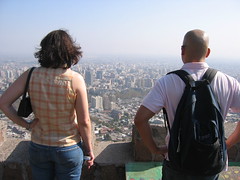Old friends on a new continent
4 April 2007
3:49 PM
Two weeks ago I didn’t write anything online because there was simply no time to do it. I was busy catching up with Percival and Kate, two friends from college who I hadn’t seen (like most of my friends!) since graduation day. Their visit almost didn’t happen—the East Coast blizzard that hit on March 16 canceled their flight for two days, then their rescheduled flight barely got them to their connection in Miami. When they did arrive, we had to make up for lost time by squeezing as much as possible into seven days.
After they landed, we wasted no time with resting or eating. We went on a walking tour of Santiago, from the main Alemeda to the Plaza de Armas and Mercado Central. I also made them climb Santa Lucia, the park on a hill in the middle of downtown. I got away with these things mostly because we hadn’t seen one another in almost two years, but also because Kate is into intense vacations too. We drag Percival along with us.
From Santiago we traveled west for a day to see Valparaiso and Vi˜a del Mar. Though it was overcast, we still saw the city’s historic quarter, Cerro Concepción, and Pablo Neruda’s house La Sebastiana. We also took a taxi ride more thrilling than most roller coasters and a good bit more life-threatening as well.
The next day we came home to my town of Los Andes. There we visited a little archaeological museum, which I, strangely enough, had never taken the time to see. Kate, who studied anthropology and did her senior thesis on pottery, explained some of the pieces to us. We marveled at the museum’s prize piece, a mummified mother and child preserved in the dry sands of the Atacama desert. At sunset we continued with our theme of hill climbing by hiking up Cerro Patagual down the street from my house. In the morning we took a tour of the nearby vineyard, San Esteban, and visited the sanctuary of Chile’s first saint, Teresa of Los Andes.
To make the trip truly international, we decided to end the week with a field trip to Argentina. Mendoza is the closest city in Argentina, on the opposite side of the Andes mountain range from my city. The steep roads make the trip long; it takes six hours to cross just 115 miles. The payoff is the amazing passage through the mountains. At one point we zig-zagged up a Andes-sized version of Lombard Street in San Francisco. Cars, vans, semi-rigs, and double-decker buses like ours snakes along the road. The vehicles looked like toys in comparison to the mountains rising around them.
In Mendoza we made a rafting excursion down the Mendoza River. I was undeterred by the fact that none of Kate, Percival, or Caitlin had been rafting before, nor by Percival’s failed swimming classes in college: I signed us up for the all-day trip on “moderate to difficult” rapids. It was a blast. The four of us were alone in a raft with our sometimes encouraging, sometimes critical guide Mario. He was very concerned about our paddling form. To his credit, once we had been coached sufficiently, I think we looked fantastic on the river. Our form was top-notch, and you would never have guessed that we collectively knew zilch about rafting. A hidden photographer took pictures of our descent. According to her pictures, I surprisingly don’t seem to know how to hold my paddle. I maintain that it’s just a problem with her lens.
I feel compelled to point out that Percival’s face is not one of sheer terror, but one of trying to save his contact lenses from the vicious rapids. If you’re curious as to what happens with all that water approaching the raft, check out this picture.
The next day we strolled through Mendoza numerous, impressive plazas and ate ice cream while we nursed our sore bodies. In the evening, we took the bus back to Santiago. The following day, after some last minute sight-seeing—the Pre-Colombian Art Museum and Neruda’s Santiago house—I dropped my friends off at the airport and sent them back home exhausted. Sometimes the best vacations are the ones where you need a post-vacation vacation to recover.





Comments